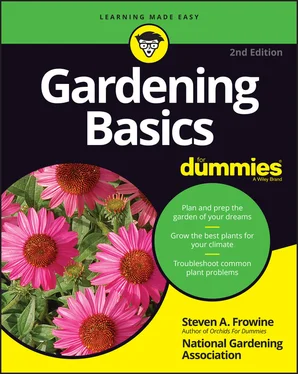Give your plants what they need to grow and flower to their best.
Buy the right tools for the job and know how to use them.
Chapter 1
Getting Ready for Gardening
IN THIS CHAPTER
 Understanding how plants are named
Understanding how plants are named
 Examining flowering plants
Examining flowering plants
 Checking out trees, shrubs, and vines
Checking out trees, shrubs, and vines
 Managing your lawn
Managing your lawn
No matter what your main gardening interest — be it growing vegetables, making your yard colorful with flowers, picking out just the right tree, or aspiring to have the most gorgeous roses on the block — chances are that you care most about the plants. Sure, gardening can also involve landscaping and lawn care (see the chapters in Part 3of this book), or being able to grow your own food ( Part 4), or just having a great excuse to play in the dirt ( Part 5), but for most people, the plants make everything worthwhile.
Okay, yeah, I know, you already know you need to plan and prepare your soil to get your garden going, but you really just want to read about plants right now, right? In that case, the rest of this chapter is devoted to the most basic explanations of the kinds of plants you may encounter in the world of gardening. Later chapters in this book go into much more detail about the various types of plants, trees, bushes, and vines, but here I help you get a sense of how plants are similar and different — the first step in turning a brown thumb green. First, though, I explain a bit about names.
What’s in a name? For gardeners, plenty. Gardening is a blend of horticulture and botany, common names and high science, and the names can get a bit confusing. Whether you’re looking at plant anatomy or simply want to know what to call a plant, understanding a bit about naming can help you wade through the garden center aisles, ask better questions, and treat your plants right.
Getting used to plant nomenclature
Whenever you’re talking about plants, knowing how they’re named can help you avoid getting tangled up in the Latin or Greek. Generally, when looking for plants and flowers, you encounter two types of names — botanical and common. Read on for some info on how the naming system works, and then carpe diem — pluck the day!
 There is a reason why Latin and Greek are the languages used in naming plants. Latin and Greek have always been the language of scholarship, for scientists worldwide. They’re unchanging, unlike the modern, daily-use language.
There is a reason why Latin and Greek are the languages used in naming plants. Latin and Greek have always been the language of scholarship, for scientists worldwide. They’re unchanging, unlike the modern, daily-use language.
The botanical name is the proper or scientific name of a plant. It consists of two parts and is called a binomial (bi equals two, nomial equals name ):
The species name: The species name is kind of like your own first name (except it comes last in a plant’s botanical name).
The genus name: The genus name is similar to your family name (except in botanical names, it comes first).
For example, in the plant name Hosta undulata, Hosta is the genus name, and undulata is the species name. Hosta describes an entire genus of popular, mostly shade-loving plants named hostas, and undulata describes the type of hosta it is — a hosta with an undulating leaf shape.
 The singular and plural for the word species is species.
The singular and plural for the word species is species.
Sometimes the botanical name has a third name, right after the species name, known as the botanical variety. A botanical variety is a member of the same plant species but looks different enough to warrant its own name, such as Rosa gallica var. officinalis.
Still another botanical name that sometimes comes up is the cultivar, short for cultivated variety. Cultivars are usually named by the people who developed or discovered them, and they’re often maintained through asexual or vegetative propagation for example by cuttings, seed propagation, or the most-modern method of raising large numbers of identical plants in test tubes, called tissue culture. In other words, they’re cultivated (humans grow, improve, and develop them). An example is Lychnis coronaria ‘Angel’s Blush.’ You can use or modify some of these techniques to make more plants yourself. For more details about how to, see Chapter 10.
 A hybrid plant is the result of the cross-pollination between two genetically different plants, usually of the same species but different varieties. This combination can happen with human intervention, when the object is to make a new or improved plant or it can occur naturally through bee pollination between two different plants.
A hybrid plant is the result of the cross-pollination between two genetically different plants, usually of the same species but different varieties. This combination can happen with human intervention, when the object is to make a new or improved plant or it can occur naturally through bee pollination between two different plants.
Botanical names are more common with some types of plants than others. For instance, you frequently run into them with herbaceous plants, trees, and shrubs but much less so with roses, annuals, and vegetables. You can find botanical names on the labels and in many garden references.
Even though botanical names can be a bit intimidating and sometimes a pain to remember, they’re much more definitive than common names. They’re recognized internationally so anywhere you are in the world, fellow plant lovers will know what plant you’re talking about.
Common names are what you’re most likely to encounter when shopping for plants to put in your garden, and they’re what you mostly encounter in this book. You can find these names prominently displayed on seed packets or on seedling trays of plants that are for sale. They’re kind of like botanical nicknames that gardeners use to describe a certain type of plant without going into a great amount of detail. For example, the Hosta undulata fits into the genus Hosta, so most gardeners merely refer to these plants under the common name of hostas. And you may know that Hemerocallis is actually the genus name for the common daylily, but chances are that most gardeners you encounter just call them daylilies.
SHARING NAMES WITH DISTANT RELATIVES
If you want to be absolutely sure of the plant you’re buying, then remember that the botanical or scientific name, including the cultivar name, is the most exact one. Some common names, like common basil, are very specific. All common basil has the same genus and species, Ocimum basilicum. However, a common name like daisy is so general that it may not be very helpful. This term can apply to plants very faintly related found in various genera (genuses). For instance, a “daisy” can be an African daisy ( Arctotis or Gerbera ), Dahlberg daisy (Dyssodia tenuiloba), English daisy (Bellis perennis), painted daisy (Chrysanthemum coccineum), Shasta daisy (Leucanthemum superbum), and many others. If you’re shopping by common names, read labels to make sure this particular kind of plant can grow for you.
Читать дальше

 Understanding how plants are named
Understanding how plants are named There is a reason why Latin and Greek are the languages used in naming plants. Latin and Greek have always been the language of scholarship, for scientists worldwide. They’re unchanging, unlike the modern, daily-use language.
There is a reason why Latin and Greek are the languages used in naming plants. Latin and Greek have always been the language of scholarship, for scientists worldwide. They’re unchanging, unlike the modern, daily-use language. A hybrid plant is the result of the cross-pollination between two genetically different plants, usually of the same species but different varieties. This combination can happen with human intervention, when the object is to make a new or improved plant or it can occur naturally through bee pollination between two different plants.
A hybrid plant is the result of the cross-pollination between two genetically different plants, usually of the same species but different varieties. This combination can happen with human intervention, when the object is to make a new or improved plant or it can occur naturally through bee pollination between two different plants.










